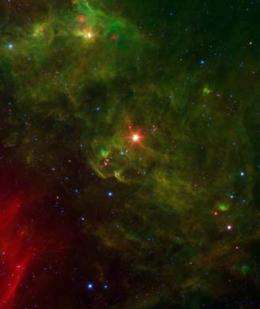Flaring Young Stars

(PhysOrg.com) -- The constellation of Vela (visible only from the southern hemisphere) contains a set of giant clouds of gas and dust known collectively as the Vela Molecular complex.
The Vela clouds contain millions of solar-masses of gas and dust that are gradually coalescing to produce stars. Over the past few decades, astronomers have learned about many of the processes associated with star formation by studying clouds like these. They have been hampered in this research, however, by the fact that most of the luminosity from star forming regions is emitted by warm dust at far-infrared wavelengths that are absorbed by the earth's atmosphere and so cannot be seen from the ground.
One of the questions still to be answered is how a developing young star grows or evolves in time. It is thought that material from a surrounding disk accretes onto the stellar surface, but when or how this happens is not known, and the process often takes place in regions with enough warm dust to block the visible light.
This winter's Astrophysical Journal includes two papers on Vela that help to clarify these questions. SAO astronomers Massimo Marengo, Giovanni Fazio, and Howard Smith, together with an international team of scientists, used the BLAST (Balloon-borne Large Aperture Submillimeter Telescope) facility to map the Vela Molecular Cloud in far infrared wavelengths where studies had never before been possible. The BLAST instrument is a prototype of the one used in Herschel, a new orbiting infrared space telescope just beginning its operations. In the first paper, the team used their new far infrared maps to identify and classify the young stars in Vela, and in particular to begin the process of modeling the far infrared light from both the ambient dust and from the disks and envelopes around the embedded young stars.
The issue of stellar embryonic growth is the focus of a second paper by the same team. It is known from optical studies that young stars sometimes flare, and objects showing these bright events are known as "EXors" (named after the prototype object, EX Lupi) or "FUors" (named after the much brighter prototype, FU Ori). One suggestion for the flaring is that it results when the star accretes new material. The astronomers used the Infrared Array Camera on the Spitzer Space Telescope to look at young protostars in the Vela Cloud in two epochs separated by six months. They found that of the over 170,000 stars in this giant nursery, forty seven were detected with significant brightness changes (consistent with flaring) during this period.
Closer analysis of these stars found that nineteen had properties (mass, age, environment) common to known EXors, and eight have properties that clearly identify them as being very young, perhaps only a few hundred thousand years old, with disks of gas and dust around each of them. Although follow-up studies are now warranted to refine the conclusions, the new papers mark a series of breakthroughs in unraveling the detailed mechanisms that shape a star's early life, and hence the lives of any potential planetary companions.
Provided by Harvard-Smithsonian Center for Astrophysics


















